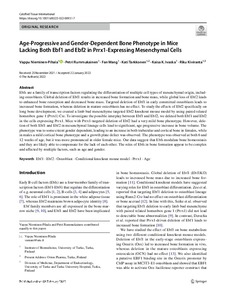| dc.contributor.author | Nieminen-Pihala Vappu | |
| dc.contributor.author | Kiviranta Riku | |
| dc.contributor.author | Wang Fan | |
| dc.contributor.author | Tarkkonen Kati | |
| dc.contributor.author | Ivaska Kaisa K | |
| dc.contributor.author | Rummukainen Petri | |
| dc.date.accessioned | 2022-10-27T11:55:24Z | |
| dc.date.available | 2022-10-27T11:55:24Z | |
| dc.identifier.uri | https://www.utupub.fi/handle/10024/155932 | |
| dc.description.abstract | Ebfs are a family of transcription factors regulating the differentiation of multiple cell types of mesenchymal origin, including osteoblasts. Global deletion of Ebf1 results in increased bone formation and bone mass, while global loss of Ebf2 leads to enhanced bone resorption and decreased bone mass. Targeted deletion of Ebf1 in early committed osteoblasts leads to increased bone formation, whereas deletion in mature osteoblasts has no effect. To study the effects of Ebf2 specifically on long bone development, we created a limb bud mesenchyme targeted Ebf2 knockout mouse model by using paired related homeobox gene 1 (Prrx1) Cre. To investigate the possible interplay between Ebf1 and Ebf2, we deleted both Ebf1 and Ebf2 in the cells expressing Prrx1. Mice with Prrx1-targeted deletion of Ebf2 had a very mild bone phenotype. However, deletion of both Ebf1 and Ebf2 in mesenchymal lineage cells lead to significant, age progressive increase in bone volume. The phenotype was to some extent gender dependent, leading to an increase in both trabecular and cortical bone in females, while in males a mild cortical bone phenotype and a growth plate defect was observed. The phenotype was observed at both 6 and 12 weeks of age, but it was more pronounced in older female mice. Our data suggest that Ebfs modulate bone homeostasis and they are likely able to compensate for the lack of each other. The roles of Ebfs in bone formation appear to be complex and affected by multiple factors, such as age and gender. | |
| dc.language.iso | en | |
| dc.publisher | SPRINGER | |
| dc.title | Age-Progressive and Gender-Dependent Bone Phenotype in Mice Lacking Both Ebf1 and Ebf2 in Prrx1-Expressing Mesenchymal Cells | |
| dc.identifier.urn | URN:NBN:fi-fe2022081153750 | |
| dc.relation.volume | 110 | |
| dc.contributor.organization | fi=tyks, vsshp|en=tyks, vsshp| | |
| dc.contributor.organization | fi=biolääketieteen laitos, yhteiset|en=Institute of Biomedicine| | |
| dc.contributor.organization-code | 2607100 | |
| dc.converis.publication-id | 174492267 | |
| dc.converis.url | https://research.utu.fi/converis/portal/Publication/174492267 | |
| dc.format.pagerange | 758 | |
| dc.format.pagerange | 746 | |
| dc.identifier.jour-issn | 0171-967X | |
| dc.okm.affiliatedauthor | Tarkkonen, Kati | |
| dc.okm.affiliatedauthor | Dataimport, tyks, vsshp | |
| dc.okm.affiliatedauthor | Ivaska-Papaioannou, Kaisa | |
| dc.okm.affiliatedauthor | Wang, Fan | |
| dc.okm.affiliatedauthor | Rummukainen, Petri | |
| dc.okm.affiliatedauthor | Kiviranta, Riku | |
| dc.okm.affiliatedauthor | Nieminen-Pihala, Vappu | |
| dc.okm.discipline | 3111 Biomedicine | en_GB |
| dc.okm.discipline | 3111 Biolääketieteet | fi_FI |
| dc.okm.internationalcopublication | not an international co-publication | |
| dc.okm.internationality | International publication | |
| dc.okm.type | Journal article | |
| dc.publisher.country | United States | en_GB |
| dc.publisher.country | Yhdysvallat (USA) | fi_FI |
| dc.publisher.country-code | US | |
| dc.relation.doi | 10.1007/s00223-022-00951-7 | |
| dc.relation.ispartofjournal | Calcified Tissue International | |
| dc.year.issued | 2022 | |
